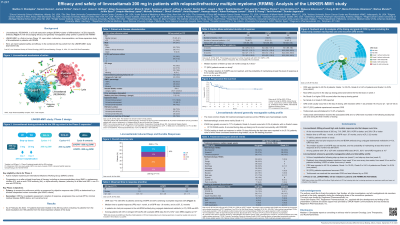Treatment of Relapsed/Refractory Myeloma
Poster Session 2
P-247: Efficacy and safety of linvoseltamab 200 mg in patients with relapsed/refractory multiple myeloma (RRMM): Analysis of the LINKER-MM1 study
Thursday, September 28, 2023
12:30 PM - 1:30 PM EEST


Madhav V. Dhodapkar, MD, MBBS (he/him/his)
Director, Center for Cancer Immunology
Winship Cancer Institute, Emory University, Atlanta, GA, USA
Atlanta, Georgia, United States
Introduction: Linvoseltamab is a fully human BCMA×CD3 bispecific antibody (Ab) that demonstrated encouraging efficacy and a generally manageable safety profile in patients (pts) with RRMM in a Phase (Ph) 1/2 dose-escalation/expansion study (LINKER-MM1; Lee et al. ASCO 2023). Here, we report a detailed analysis of pts who received linvoseltamab 200 mg, identified as the recommended dose.
Methods: LINKER-MM1 (NCT03761108) enrolled adults with MM who progressed on/after ≥3 lines of therapy (LoT) including a proteasome inhibitor (PI), an immunomodulatory drug (IMiD), and an anti-CD38 Ab; the Ph 2 portion also included pts who were ≥triple-class (PI/IMiD/anti-CD38 Ab) refractory. In Ph 2, pts received linvoseltamab QW in Cycles 1–3 followed by Q2W dosing; dosing frequency was reduced to Q4W for pts who achieved ≥VGPR after Cycle 6. The Ph 2 primary endpoint was objective response rate (ORR). Key secondary endpoints included duration of response and minimal residual disease (MRD) status.
Results: As of Feb 28, 2023, 117 pts had received linvoseltamab 200 mg (Ph 1, n=12; Ph 2, n=105): Median age, 70 yrs (range 37–91); Black/African American ethnicity, 17%; extramedullary plasmacytomas, 14%; high-risk cytogenetics, 36%; bone marrow plasma cells ≥50%, 22%. Pts had received a median of 5 (range 2–14) prior LoT, and 74% were ≥triple-class refractory.
ORR was 71%, with 59% of pts achieving ≥VGPR and 30% achieving ≥CR, at a median duration of follow-up of 5.6 months (range 0.2–28.2). Median time to ≥VGPR and ≥CR was 1.87 months and 5.32 months, respectively. In pts who had prior BCMA-targeted therapy exposure with belantamab mafodotin (n=10), ORR was 60%. The median duration of ≥VGPR was not reached, and the probability of maintaining at least this level of response at 6/12 months was 89%/83%.
The most common TEAEs (>30%) were cytokine release syndrome (CRS; 45% [Gr 3: 1%]), cough (33% [Gr ≥3: 0]), fatigue (32% [Gr ≥3: 0]), diarrhea (32% [Gr ≥3: 2%]), and neutropenia (32% [Gr ≥3: 31%]). CRS onset usually occurred on the day of dosing (median [range] time to first CRS onset from most recent dose, 14.8 h [0–177]), and resolved within 1 day (median [range] CRS duration, 16.5 h [1–144]); a temporal analysis to understand the relationship between tocilizumab use and recurrent CRS will be presented. ICANS (investigator-assessed) was reported in 6% (Gr ≥3: 3%) of pts. Infections occurred in 60% (Gr ≥3: 37%; Gr 5: 9%) of pts, with the most commonly identified infection types being pneumonia (17%; Gr ≥3: 14%), COVID-19 (12%; Gr ≥3: 5%) and upper respiratory tract infection (12%; Gr ≥3: 3%).
Conclusions: Linvoseltamab 200 mg is efficacious and shows a generally manageable safety profile in triple-class exposed pts. We will present additional analyses, including the timing and durability of deep (≥VGPR) responses to linvoseltamab, and MRD status, which support further investigation at the recommended dose.
Methods: LINKER-MM1 (NCT03761108) enrolled adults with MM who progressed on/after ≥3 lines of therapy (LoT) including a proteasome inhibitor (PI), an immunomodulatory drug (IMiD), and an anti-CD38 Ab; the Ph 2 portion also included pts who were ≥triple-class (PI/IMiD/anti-CD38 Ab) refractory. In Ph 2, pts received linvoseltamab QW in Cycles 1–3 followed by Q2W dosing; dosing frequency was reduced to Q4W for pts who achieved ≥VGPR after Cycle 6. The Ph 2 primary endpoint was objective response rate (ORR). Key secondary endpoints included duration of response and minimal residual disease (MRD) status.
Results: As of Feb 28, 2023, 117 pts had received linvoseltamab 200 mg (Ph 1, n=12; Ph 2, n=105): Median age, 70 yrs (range 37–91); Black/African American ethnicity, 17%; extramedullary plasmacytomas, 14%; high-risk cytogenetics, 36%; bone marrow plasma cells ≥50%, 22%. Pts had received a median of 5 (range 2–14) prior LoT, and 74% were ≥triple-class refractory.
ORR was 71%, with 59% of pts achieving ≥VGPR and 30% achieving ≥CR, at a median duration of follow-up of 5.6 months (range 0.2–28.2). Median time to ≥VGPR and ≥CR was 1.87 months and 5.32 months, respectively. In pts who had prior BCMA-targeted therapy exposure with belantamab mafodotin (n=10), ORR was 60%. The median duration of ≥VGPR was not reached, and the probability of maintaining at least this level of response at 6/12 months was 89%/83%.
The most common TEAEs (>30%) were cytokine release syndrome (CRS; 45% [Gr 3: 1%]), cough (33% [Gr ≥3: 0]), fatigue (32% [Gr ≥3: 0]), diarrhea (32% [Gr ≥3: 2%]), and neutropenia (32% [Gr ≥3: 31%]). CRS onset usually occurred on the day of dosing (median [range] time to first CRS onset from most recent dose, 14.8 h [0–177]), and resolved within 1 day (median [range] CRS duration, 16.5 h [1–144]); a temporal analysis to understand the relationship between tocilizumab use and recurrent CRS will be presented. ICANS (investigator-assessed) was reported in 6% (Gr ≥3: 3%) of pts. Infections occurred in 60% (Gr ≥3: 37%; Gr 5: 9%) of pts, with the most commonly identified infection types being pneumonia (17%; Gr ≥3: 14%), COVID-19 (12%; Gr ≥3: 5%) and upper respiratory tract infection (12%; Gr ≥3: 3%).
Conclusions: Linvoseltamab 200 mg is efficacious and shows a generally manageable safety profile in triple-class exposed pts. We will present additional analyses, including the timing and durability of deep (≥VGPR) responses to linvoseltamab, and MRD status, which support further investigation at the recommended dose.
